外科病理学实践:诊断过程的初学者指南 | 第12章 膀胱
第12章 膀胱(Bladder)
Bladder biopsy specimens are usually submitted to rule out a urothelial neoplasm. The procedure may be indicated because of hematuria, an abnormal urine cytology, a history of urothelial neoplasm, or a lesion seen on cystoscopy. The cystoscopic impression is important, and you usually do not diagnose a papillary lesion if none was seen by the urologist. The bladder biopsy specimen is typically a tiny tissue fragment, so you should look at each level carefully.
膀胱活检标本通常用于排除尿路上皮肿瘤。活检指征可能包括血尿、尿细胞学异常、尿路上皮肿瘤病史或膀胱镜检查发现的病变。膀胱镜检查的印象很重要,如果泌尿科医生没有看到任何病变,那你通常不要诊断乳头状病变。膀胱活检标本通常是一块很小的碎组织,所以你应该仔细观察每个层面。
(译注:这种活检小组织第一次切片应该提供3-5个层面)
The normal urothelium consists of a stratified nonsquamous epithelium, also called transitional cell epithelium. It consists of a five- to seven-cell thick layer of uniform cells that do not significantly mature as they reach the surface (unlike squamous epithelium) and that tend to have oblong nuclei oriented perpendicular to the surface (Figure 12.1). The nuclei are about two to three times the size of lymphocytes. Mitoses are usually seen only at the basal layer, but in the presence of inflammation and reactive changes they may be seen throughout. At the surface is a specialized cell layer called the umbrella cells, large pillowy cells that appear wider than the underlying urothelial cells. Umbrella cells may have atypical nuclei and should be ignored when assessing the urothelium for neoplasia.
正常尿路上皮由复层非鳞状上皮组成,也称为移行细胞上皮。它由5-7层细胞厚度的形态均匀的细胞组成,这些细胞在到达表面时不会明显成熟(与鳞状上皮不同),并且往往具有垂直于表面的长方形核(图12.1)。核大约是淋巴细胞大小的2-3倍。核分裂通常仅见于基底层,但在存在炎症和反应性改变的情况下,核分裂象可能遍布全层。表面是一种特化细胞层,称为伞细胞,是一种比下方的尿路上皮细胞更宽的枕状细胞。伞细胞可能有非典型核,在评估尿路上皮肿瘤时忽略不计。
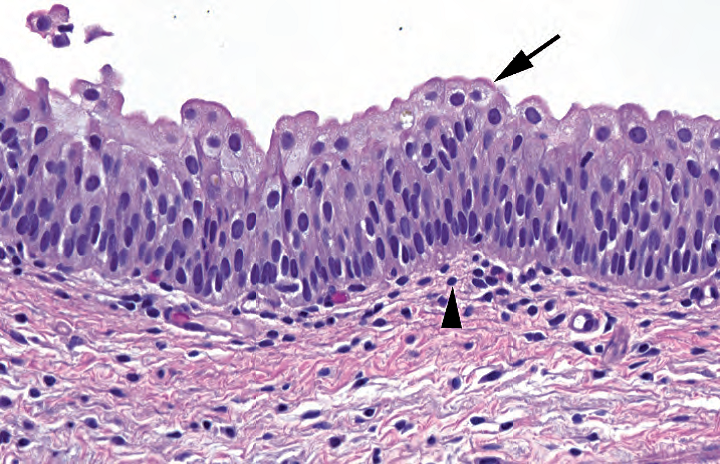
Figure 12.1. Normal urothelium. The urothelial cells form a layer five to seven cells thick, with large umbrella cells sitting on top (arrow). The urothelial nuclei are generally polarized and oriented perpendicular to the surface, with the exception of the umbrella cells. The nuclei are two to three times the size of a lymphocyte (arrowhead).
图12.1.正常尿路上皮。尿路上皮细胞形成5-7层细胞厚度,顶部有大的伞细胞(箭)。尿路上皮核通常极化并垂直于表面,伞细胞除外。核的大小是淋巴细胞的2-3倍(箭头)。
Underneath the urothelium lies the lamina propria, a connective tissue layer that has vessels, lymphatics, occasional smooth muscle fibers, and even occasional fat. Deep to this is the thick muscularis propria, also known as the detrusor muscle. Beyond the muscular wall is either adventitia or, where the bladder lies against the peritoneum, peritonealized serosa.
尿路上皮下方是固有层,这是结缔组织层,有血管、淋巴管,偶有平滑肌纤维,甚至偶尔有脂肪。深部是较厚的固有肌层,也称为逼尿肌。在肌壁之外是外膜,或者在膀胱靠腹膜的部位是腹膜化浆膜。
正常变异(Normal Variants)
Some changes in the bladder are so common that they are essentially normal. One of these changes is the formation of von Brunn’s nests, which are downward invaginations of the urothelium into the lamina propria (Figure 12.2). These can look alarmingly like urothelial nests that are invading the bladder, but they should have bland urothelium that looks just like normal urothelium (see below for a description of neoplastic urothelium) and have a smooth rounded border. As these nests progress, they may acquire a dilated central lumen (cystitis cystica), columnar cell metaplasia (cystitis glandularis; see Figure 12.2), and even intestinal metaplasia with mucin production. They are still benign. However, just as high-grade squamous intraepithelial lesions can involve endocervical glands, in situ urothelial carcinoma can grow down into von Brunn’s nests, mimicking invasion. Another normal variant is the formation of squamous metaplasia, especially in the trigone area of the female bladder.
膀胱的某些改变非常常见,基本上是正常的。其中一种改变是形成von Brunn巢(布氏巢),即尿路上皮向下内陷到固有层(图12.2)。它们看起来令人担心,像是浸润膀胱的尿路上皮巢,但它们应该有形态温和的尿路上皮,看起来像正常的尿路上皮(见下文肿瘤性尿路上皮的描述),并有光滑的圆形边界。随着这些巢的发育,它们可能产生扩张的中央管腔(膀胱炎)、柱状细胞化生(腺性膀胱炎;见图12.2),甚至有产生黏液的肠化生。它们仍然是良性的。然而,正如高度鳞状上皮内病变可累及宫颈管腺体一样,原位尿路上皮癌也可以向下生长到布氏巢中,假冒浸润。另一种正常变异是形成鳞状化生,尤其是在女性膀胱三角区。
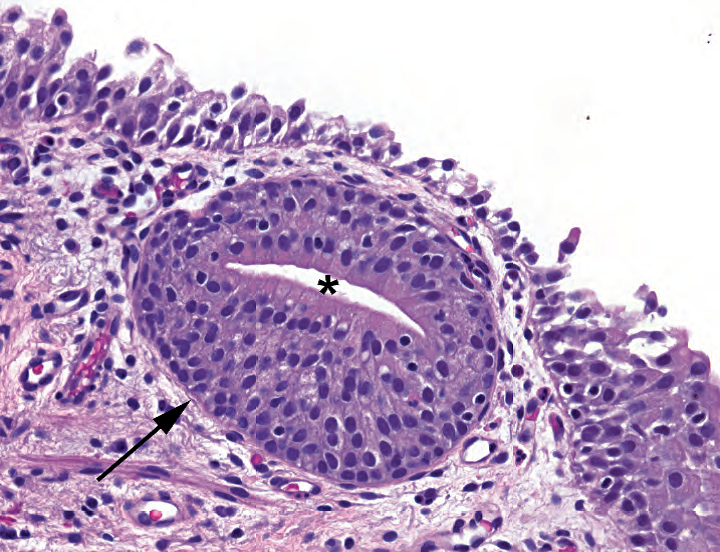
Figure 12.2. Von Brunn’s nest and cystitis glandularis. The normal urothelium has invaginated down into the lamina propria, forming a rounded von Brunn’s nest (arrow). The center of the nest has acquired a lumen and columnar cell metaplasia (asterisk), which is known as cystitis glandularis.
图12.2.布氏巢和腺性膀胱炎。正常的尿路上皮已经内陷到固有层,形成圆形的布氏巢(箭)。巢的中心出现了管腔和柱状细胞化生(星号),称为腺性膀胱炎。
炎症(膀胱炎)(Inflammation (Cystitis))
There are several types of inflammatory disease that you may see. One is granulomatous cystitis, which once was largely caused by tuberculosis but is now more likely to be secondary to Bacillus Calmette-Guerin (BCG) therapy—a topical chemotherapy for urothelial carcinoma. The intravesical injection of BCG causes an intense inflammatory response that may wipe out the carcinoma.
你可能会看到几种类型的炎症性疾病。一种是肉芽肿性膀胱炎,以前主要由结核病引起,但现在更可能继发于卡介苗(BCG)疗法——一种治疗尿路上皮癌的局部化疗。膀胱内注射卡介苗会引起强烈的炎症反应,可能会清除癌。
Parasitic infection, most commonly by Schistosoma species, is still common in undeveloped countries but rare in the United States. The inflammatory response is actually not caused by the organisms but by their eggs, which are extruded into the bladder wall and cause intense foreignbody reaction. Polypoid cystitis is similar to an inflammatory polyp of the bladder and is associated with any process that injures the bladder (e.g., indwelling catheters, calculi, fistula from the colon). Interstitial cystitis is a poorly understood disease that is mainly a cystoscopic diagnosis and more a diagnosis of exclusion for the pathologist.
寄生虫感染,最常见的是血吸虫,在不发达国家仍然常见,但在美国罕见。炎症反应实际上不是由病原体引起的,而是由卵引起,卵被挤入膀胱壁并引起强烈的异物反应。息肉样膀胱炎类似于膀胱炎性息肉,与任何损伤膀胱的过程有关(如留置导管、结石、结肠瘘)。间质性膀胱炎是一种鲜为人知的疾病,主要是膀胱镜诊断,而病理医师是排除性诊断。
Malakoplakia is one of those mysterious rare entities that most residents do not see, think about, or understand until they are studying for boards. It is a descriptive name for the yellow plaques seen on cystoscopy, which are formed by sheets of epithelioid histiocytes sporting characteristic round inclusions called Michaelis-Guttman bodies (they look like archery targets). It is caused by a defective macrophage response to infection.
软化斑是一个神秘而罕见的实体,大多数住院医师在为考取行医执照之前都不会看到、思考或理解它。这是膀胱镜检查中黄色斑块的描述性名称,由上皮样组织细胞构成,这些组织细胞运动着称为Michaelis-Guttman小体(软斑病小体)的特征性圆形内含物(它们看起来像箭靶)。它是由巨噬细胞对感染的反应缺陷引起的。
尿路上皮肿瘤(Urothelial Neoplasms)
Urothelial neoplasms are categorized into two cancer pathways: flat and papillary. Both can lead to invasive carcinoma, but the terminology is different. About 90% of bladder carcinomas are urothelial, so this will be the focus of this chapter.
尿路上皮肿瘤分为两种致癌途径:平坦和乳头状。两者均可导致浸润性癌,但术语不同。大约90%的膀胱癌是尿路上皮癌,所以这将是本章的重点。
Flat neoplasia does not form an exophytic lesion but may still be visible on cystoscopy as a red area. It progresses through dysplasia (rarely diagnosed) to carcinoma in situ. Flat urothelial carcinoma in situ is just known as carcinoma in situ (CIS) and can go on to high-stage invasive carcinoma without ever making an exophytic lesion, so always scrutinize the urothelium at high power, especially in denuded areas. Features of CIS include the following:
平坦肿瘤不形成外生性病变,但在膀胱镜下仍可以看到红色区域。它通过异型增生(很少诊断)进展为原位癌。平坦型尿路上皮原位癌也可以直接称为原位癌(CIS),可进展为高级别浸润性癌,而不发生外生性病变,因此总是需要在高倍镜下检查尿路上皮,尤其是在裸露区域。CIS的特征包括:
Urothelial cells have increased nuclear size. A helpful hint is that the worst nuclei of CIS should be four to five times the size of lymphocyte nuclei (Figure 12.3).
尿路上皮细胞的核增大。一个有用的线索是,CIS最差的核应该是淋巴细胞核大小的4-5倍(图12.3)。
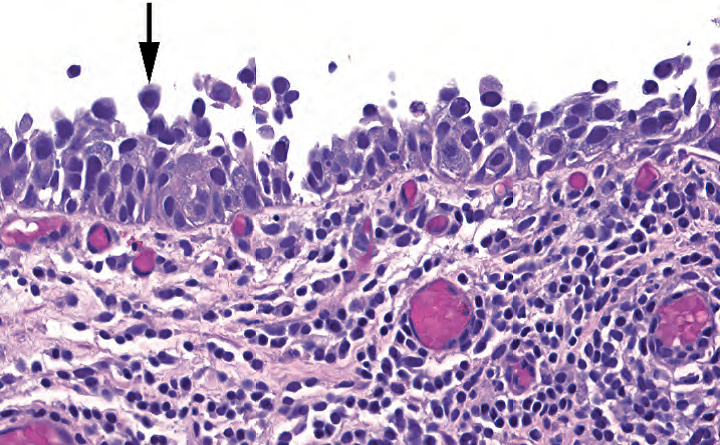
Figure 12.3. Flat carcinoma in situ. The urothelium is partially denuded (stripped of cells), but the cells that remain show enlarged, round, hyperchromatic nuclei appearing to pop off the surface (arrow). Compare the nuclear size to the underlying lymphocytes.
图12.3.平坦型原位癌。尿路上皮部分脱落(细胞脱落),但残留的细胞显示增大的圆形深染核,似乎从表面脱落(箭)。比较核的大小和下面的淋巴细胞。
There are Hyperchromatic nuclei with irregular (“boulder-like”) outlines.
有不规则(“圆石状”)轮廓的深染核。
The urothelium has a tendency to fall apart, appearing denuded, with a few clinging cells.
尿路上皮有脱落的倾向,似乎裸露,有少量黏附的细胞。
Full-thickness involvement is not a requirement to diagnosis CIS (even scattered malignant cells with the above features justify a diagnosis of CIS).
诊断CIS并不必需全层受累(即使是散在的恶性细胞,只要具有上述特征,也适宜诊断CIS)。
If a lesion has atypia that you think is neoplastic (i.e., not reactive) yet the cells are not bad enough to call CIS, then the diagnosis of dysplasia is appropriate. However, the options are limited: you should not call mild dysplasia, as urologists do not treat it, nor should you call severe dysplasia, which is the same as CIS. True dysplasia (meaning moderate dysplasia) is an uncommon diagnosis, with most bladder biopsies signed out as normal, CIS, or reactive.
如果一个病变有非典型性,你认为是肿瘤性(即,非反应性的),但细胞还不足以称为CIS,那么诊断异型增生是合适的。然而,你的选择有限:你不应该称为轻度异型增生,因为泌尿科医生不治疗它,也不应该称为重度异型增生,这与CIS相同。真正的异型增生(意思是中度异型增生)是一种少见的诊断,大多数膀胱活检报告为正常、CIS或反应性。
Papillary neoplasia has a much wider spectrum of disease, from benign papilloma to high grade carcinoma. The papillary lesions are unusual in nomenclature, however, in that despite being in situ lesions, they are conventionally just called noninvasive papillary urothelial carcinoma, either low or high grade. If you use the word in situ to refer to papillary lesions, urologists think you mean CIS. Once these cancers invade, they are called invasive papillary urothelial carcinoma and are typically high grade.
乳头状肿瘤具有更加广泛的疾病谱系,从良性乳头状瘤到高级别癌。然而,乳头状病变的命名是不同寻常的,尽管是原位病变,它们按传统称为非浸润性乳头状尿路上皮癌,低级别或高级别。如果你用原位这个词来称呼乳头状病变,泌尿科医生会认为你是说CIS。一旦这些肿瘤浸润,称为浸润性乳头状尿路上皮癌,通常为高级别。
Papillary lesions all have in common a branching architecture with delicate fibrovascular cores, and they can get quite large, even filling the bladder. The classification is determined by the cytology of the urothelial lining.
乳头状病变都有一个共同的分支结构和纤细的纤维血管轴心,它们可以长得很大,甚至充满膀胱。分类取决于被覆的尿路上皮细胞学。
乳头状瘤(Papilloma)
Papillomas are defined by having a normal urothelial lining (normal thickness, well-organized and polarized, and small nuclei, often with nuclear grooves, without mitoses; Figure 12.4). They tend to be small lesions. There is no risk of malignant transformation.
乳头状瘤的定义是被覆正常的尿路上皮(正常厚度,组织结构良好,有极性,核小,常有核沟,无核分裂;图12.4)。它们往往是小病灶。没有恶性转化的风险。
Do not be fooled by papillary hyperplasia, which is an undulating wave-like urothelium without true fibrovascular cores.
不要被乳头状增生所愚弄,乳头状增生是一种波浪起伏的尿路上皮,没有真正的纤维血管核心。
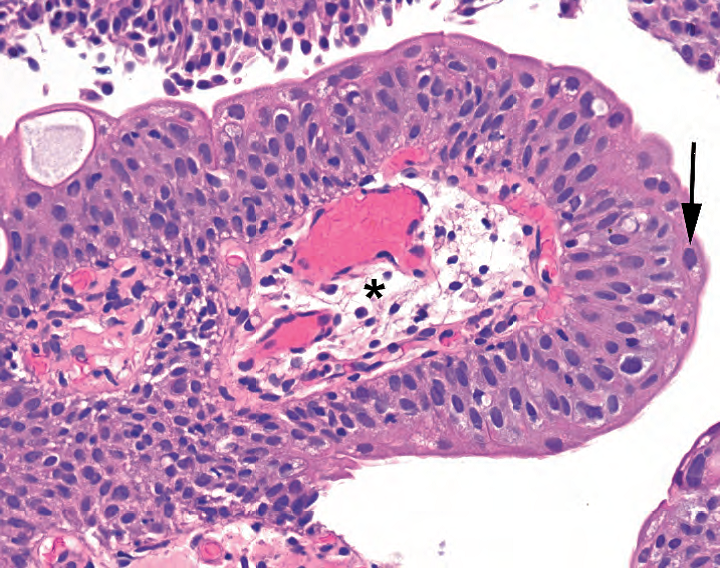
Figure 12.4. Papilloma. There is a prominent fibrovascular core (asterisk), and the urothelium resembles normal urothelium both in thickness and in bland cytology. Some large umbrella cells are visible (arrow).
图12.4.乳头状瘤。有显著的纤维血管轴心(星号),尿路上皮的厚度和形态温和的细胞学都与正常尿路上皮相似。可见一些大的伞细胞(箭)。
低恶性潜能乳头状尿路上皮肿瘤(Papillary Urothelial Neoplasm of Low Malignant Potential)
“Papillary urothelial neoplasm of low malignant potential” (PUNLMP) was recently added to the World Health Organization classification with the intent of creating a category for those proliferative neoplasms that are larger and fuller than papillomas but do not look malignant. The urothelial lining is increased in thickness but still appears well organized, with all nuclei streaming in parallel, and has near-normal nuclear/cytoplasmic ratios (Figure 12.5). Mitoses should be exceedingly rare and confined to the basal layer, as in normal urothelium.
“低恶性潜能乳头状尿路上皮肿瘤”(PUNLMP)最近被加入WHO分类,目的是为那些比乳头状瘤更大、更充满膀胱但看起来不是恶性的增殖性肿瘤创建一个分类。被覆尿路上皮的厚度增加,但组织结构仍然良好,所有核平行排列、流水状,核/质比接近正常(图12.5)。核分裂应该非常罕见,并且局限于基底层,就像正常尿路上皮一样。
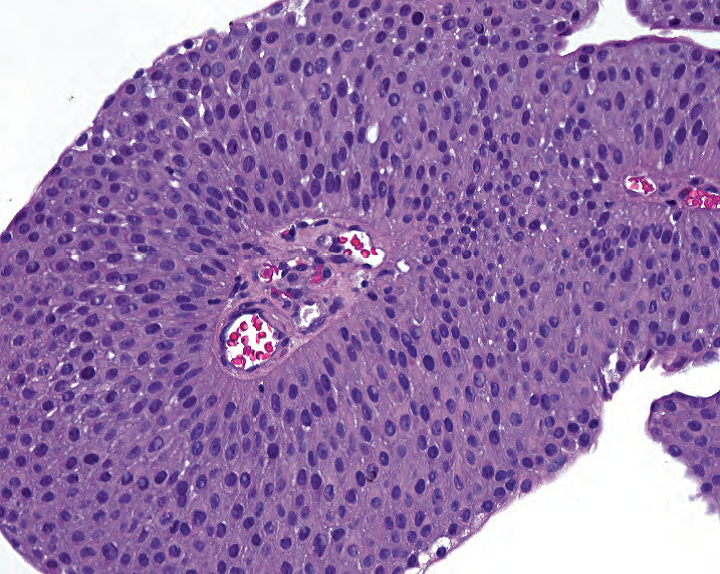
Figure 12.5. Papillary urothelial neoplasm of low malignant potential. This papillary lesion shows an increased thickness relative to normal urothelium, but the cells remain uniform and organized.
图12.5.低恶性潜能乳头状尿路上皮肿瘤。与正常尿路上皮相比,乳头状病变显示厚度增加,但细胞均匀一致,排列有序。
低级别乳头状尿路上皮癌(Low-Grade Papillary Urothelial Carcinoma)
Low-grade papillary urothelial carcinomas (Figure 12.6) have the following features:
低级别乳头状尿路上皮癌(图12.6)具有以下特征:
The urothelial lining is increased in thickness and is still in general fairly organized (the cells are still mostly polarized with respect to the surface).
被覆的尿路上皮厚度增加,总体上仍然排列有序(细胞相对于表面仍然大部分极化)。
There is scattered subtle nuclear atypia consisting of random slightly enlarged darker nuclei, in contrast to PUNLMP, in which every nucleus looks the same.
散在分布的细微核非典型性,由随机分布的稍微增大的深染核组成。这与PUNLMP不同,PUNLMP中的每个核看起来都一样。
Mitoses are uncommon, but typically you will see some of them, in contrast to PUNLMP.
核分裂少见,但通常能找到一些核分裂象,这也与PUNLMP不同。
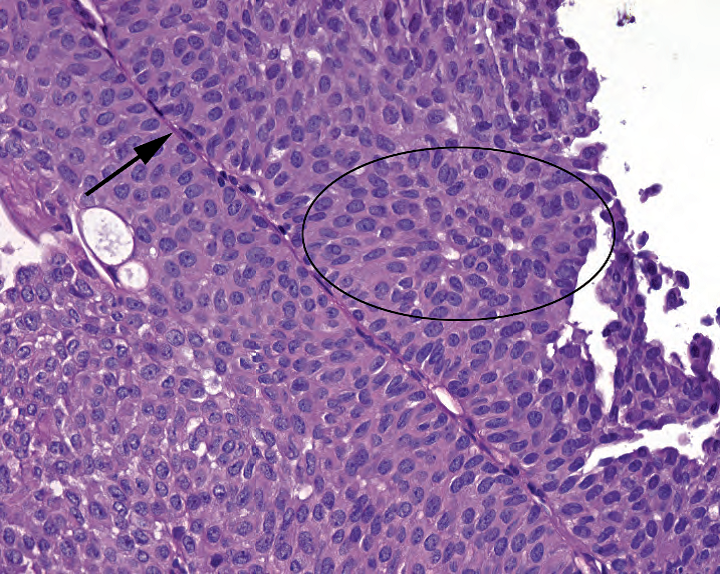
Figure 12.6. Low-grade papillary urothelial cancer. The fibrovascular cores (arrow) are lined by urothelium that is thicker than normal, increasingly disorganized (circle), and with enlarged nuclei.
图12.6.低度乳头状尿路上皮癌。纤维血管轴心(箭)被覆的尿路上皮比正常厚度更厚,越来越杂乱无章(圆圈),核增大。
高级别乳头状尿路上皮癌(High-Grade Papillary Urothelial Carcinoma)
High-grade papillary urothelial carcinoma lesions are lined by cells that look like CIS. They can be noninvasive, but you have to look carefully for associated invasion, which is often present.
高级别乳头状尿路上皮癌的被覆细胞看起来像CIS。它们可能属于非浸润性,但你必须仔细寻找是否伴随浸润,通常存在浸润。
The urothelium is very disorderly, with little nuclear orientation to the surface.
尿路上皮排列非常乱,几乎没有核朝向表面。
Nuclei are enlarged, hyperchromatic, and pleomorphic and may have nucleoli (Figure 12.7).
核增大,深染,多形性,可能有核仁(图12.7)。
Mitoses are seen at all levels of the epithelium (in a well-oriented fragment).
上皮的所有层面都可见核分裂(要观察定向良好的片段)。
Focal nonurothelial differentiation (squamous or glandular) is possible.
可能出现局灶非尿路上皮分化(鳞状或腺样)。
A small amount of high-grade characteristics (>5%) generally defines the entire lesion as high grade.
只要少量高级别特征(>5%)通常就可以把整个病变定义为高级别。
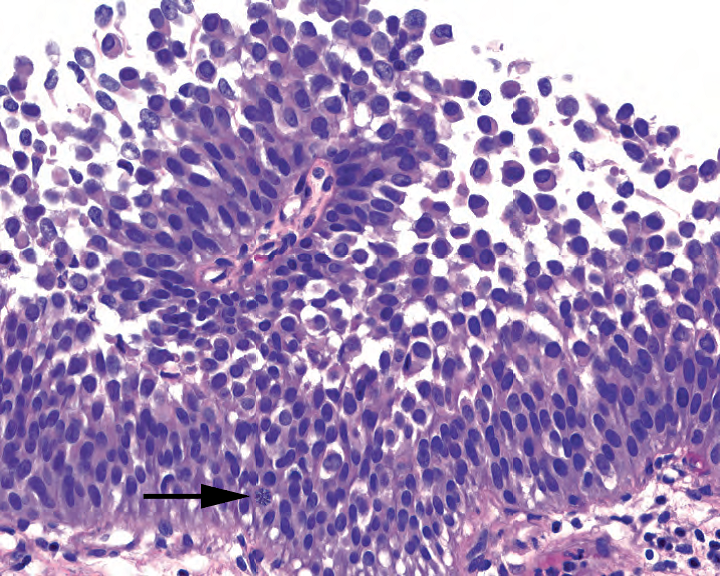
Figure 12.7. High-grade papillary urothelial cancer. This papillary lesion shows large, dark, pleomorphic nuclei popping off the surface, similar to carcinoma in situ (see Figure 12.3). A large mitotic figure is visible (arrow).
图12.7.高级别乳头状尿路上皮癌。乳头状病变显示大的、深染的、多形性核,似乎从表面弹出,类似于原位癌(见图12.3)。可见一个大的核分裂象(箭)。
浸润性尿路上皮癌(旧称“移行细胞癌”)(Invasive Urothelial Carcinoma (Formerly “Transitional Cell Carcinoma”))
Most invasive carcinomas arise in the setting of either high-grade papillary urothelial carcinoma or CIS. Identifying invasion into the lamina propria relies on similar cues as found in other organs:
大多数浸润性癌发生于高级别乳头状尿路上皮癌或CIS的情形。识别固有层浸润的方法,类似于其他器官:
Irregular tongues of cells or single cells pushing into the lamina propria
推挤并进入固有层的、不规则的细胞舌状突起或单个细胞
“Paradoxical differentiation”: the deep invasive cells acquire increased pink cytoplasm, mimicking maturing surface cells (Figure 12.8)
“反常分化”:深部浸润的细胞获得增多的粉红色细胞质,貌似成熟的表面细胞(图12.8)
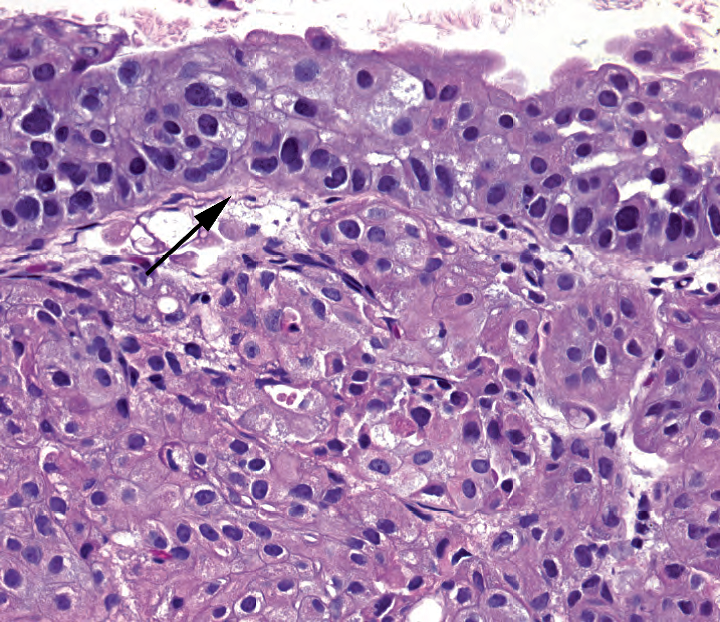
Figure 12.8. Invasive urothelial carcinoma. In this case, the carcinoma is arising out of flat carcinoma in situ, seen above the basement membrane (arrow). The nests of tumor in the lamina propria appear more pink than the surface carcinoma in situ, corresponding to paradoxical differentiation.
图12.8.浸润性尿路上皮癌。在本例中,癌起源于基底膜上方的平坦型原位癌(箭)。固有层中的肿瘤巢比表面原位癌更红(译注:且胞质更多),即反常分化。
Retraction artifact: the apparent cracking of the stroma away from tumor nests
收缩假象:肿瘤巢与间质之间明显开裂
Desmoplastic response of stroma (however, often not present)
促结缔组织增生性间质反应(但通常不存在)
Identifying the muscularis propria (detrusor muscle), and whether the tumor invades that deeply, is critically important. Superficial carcinomas that do not invade the muscularis propria may be treated conservatively by transurethral resection (TURBT) or topical chemotherapy. Invasion of the detrusor buys the patient a cystectomy. Therefore, any diagnosis of invasive carcinoma should state whether the detrusor is (1) present on the biopsy and (2) involved. Remember that wisps of smooth muscle (the discontinuous muscularis mucosae) may be found in the lamina propria, so do not overcall detrusor invasion on that basis. The detrusor is a big slab of muscle, relatively speaking (Figure 12.9).
识别固有肌层(逼尿肌),以及肿瘤是否浸润那么深,是至关重要的。不侵犯固有肌层的浅表癌可通过经尿道电切术(TURBT)或局部化疗而进行保守治疗。浸润逼尿肌让患者为膀胱切除术买单。因此,任何浸润性癌的诊断都应说明逼尿肌是否(1)存在于活检中,(2)被癌累及。记住,在固有层中可能会发现几缕平滑肌(不连续的黏膜肌层),因此不要因为看到这个而过诊断为逼尿肌浸润。相对而言,逼尿肌是一大块肌肉(图12.9)。
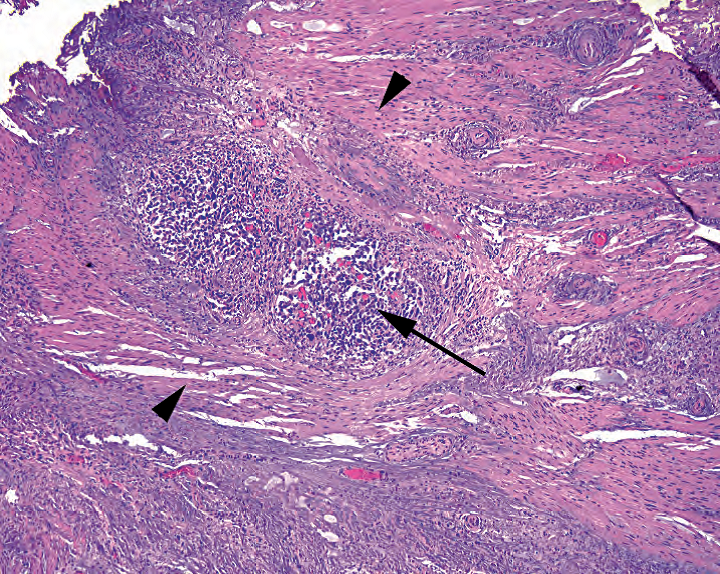
Figure 12.9. Carcinoma in detrusor muscle. Thick bands of muscle (arrowheads) are seen on either side of a nest of tumor cells (arrow).
图12.9.逼尿肌中的癌。在肿瘤细胞巢(箭)的两侧可以看到粗大的肌束(箭头)。
Also, as mentioned earlier, ugly urothelium that invades the lamina propria in broad round nests may actually be growth of CIS into von Brunn’s nests or an inverted growth pattern of a noninvasive papillary urothelial carcinoma (see the following list). The difference is that in these mimickers of invasion the nests are round and even without ragged borders, and they appear basophilic, often with crowding or palisading of the outermost layer of cells.
此外,如前所述,以宽广的圆形细胞巢形式侵犯固有层的、形态学丑陋的尿路上皮实际上可能是CIS生长到布氏巢中,或非浸润性乳头状尿路上皮癌的内翻性生长模式(见下文列举)。不同之处在于,在这些假冒浸润的巢中,巢是圆形的,甚至没有参差不齐的边界,它们看起来嗜碱性,通常最外层的细胞拥挤或栅栏状排列。
Conditions that look like cancer but are not
似癌非癌(看起来像癌但不是癌的情况)
° Inverted papilloma: As in the nose (Schneiderian papilloma), a papilloma can occasionally grow down and in, instead of up and out, creating an inside-out or inverted papilloma that is buried in stroma but does not cross the basement membrane. Like von Brunn’s nests, the urothelium should look benign, but the nests may be very closely packed into a small area or coalesced into anastomosing cords.
°内翻性乳头状瘤:正如鼻的施奈德乳头状瘤,乳头状瘤偶尔会向下向内生长,而不是向上向外生长,形成里面朝外或内翻性乳头状瘤,陷入间质但不穿透基底膜。像布氏巢一样,尿路上皮看起来应该是良性的,但是这些巢可能紧密地聚集在一个小区域中,或者合并成吻合的条索。
° Reactive changes in urothelium: As in other organs, reactive changes tend to create enlarged but euchromatic nuclei; the chromatin should be evenly blue grey and the nuclear contour smooth and oval, yet nucleoli may be very large (Figure 12.10). You should raise your threshold for CIS in the presence of extensive inflammation.
°尿路上皮反应性改变:与其他器官一样,反应性改变往往产生垓增大,但核染色正常;染色质应为均匀的蓝灰色,核轮廓平滑、椭圆形,然而核仁可能很大(图12.10)。在存在广泛炎症的情况下,应提高CIS的诊断阈值。
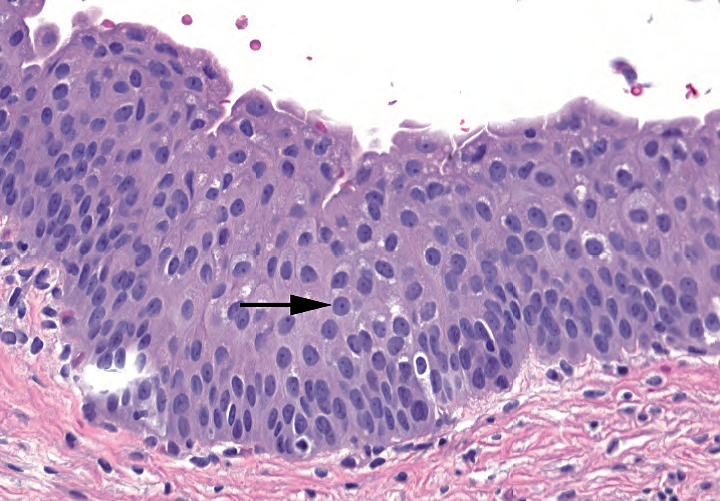
Figure 12.10. Reactive nuclei. These urothelial nuclei are somewhat enlarged and have prominent nucleoli (arrow) but retain a smooth nuclear outline and pale, even chromatin. They are benign.
图12.10.反应性核。这些尿路上皮核稍大,有明显核仁(箭),但保留平滑的核轮廓和淡染的染色质。它们是良性的。
° Nephrogenic adenoma: Nephrogenic adenoma is a benign proliferative neoplasm that can take on many appearances, including cuboidal cells lining papillae, hobnail cells lining vessel-like structures (Figure 12.11), small infiltrative-looking tubules, sometimes with thyroid-like accumulations of colloid, and small tubules mimicking signet-ring cell carcinoma. In all cases, these differ from urothelial lesions by being a single-layered cuboidal epithelium. There may be focal large dark nuclei, but they should have uniform dense chromatin and no mitoses.
° 肾源性腺瘤:肾源性腺瘤是一种良性增殖性肿瘤,可有多种表现,包括被覆在乳头上立方细胞、被覆在血管样结构上的鞋钉细胞(图12.11)、貌似浸润的小管(有时伴有甲状腺样胶质积聚),以及类似印戒细胞癌的小管。在所有病例中,与尿路上皮病变的不同之处,是单层立方上皮。可能有局灶性大的深染核,但应具有均匀致密的染色质,无核分裂。
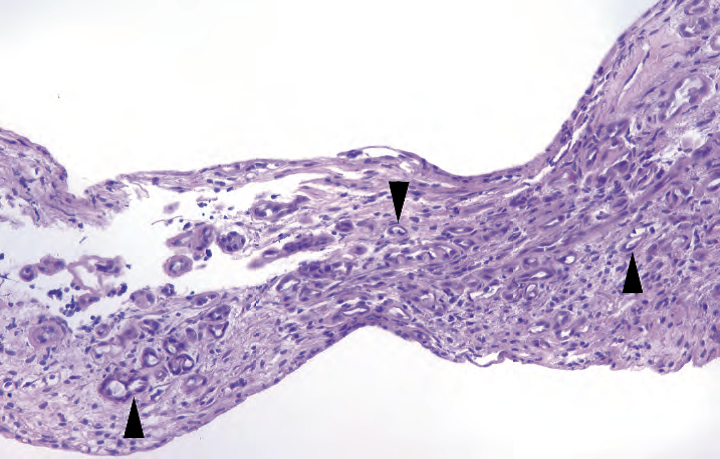
Figure 12.11. Nephrogenic adenoma. In this bladder biopsy specimen, there are multiple tiny tubules in the lamina propria (arrowheads) with prominent dark nuclei. The urothelium is not seen here.
图12.11.肾源性腺瘤。在这个膀胱活检标本中,固有层(箭头)中有多个小管,有显著的深染核。这里看不到尿路上皮。
似良非良(看起来是良性但不是良性的情况)
Conditions that look benign but are not
° Nested transitional cell carcinoma: This is an invasive urothelial carcinoma made of small, bland nests in the lamina propria that, despite looking like von Brunn’s nests, is actually an aggressive carcinoma. Great, right? Features suggestive of this lesion include an infiltrative pattern at the base of the lesion, as well as an architecturally complex pattern of closely packed small nests.
°巢状移行细胞癌:这是一种浸润性尿路上皮癌,由固有层中的小而形态温和的巢构成,尽管看起来像布氏巢,但实际上是一种浸润性癌。太刺激了,对吗?提示正确诊断的特征包括病变底部的浸润模式,以及紧密排列的小巢形成结构复杂的模式。
° Lymphoepithelial-like carcinoma: While this certainly does not look like normal bladder, lymphoepithelial-like carcinoma can be very sneaky to the pathologist in training. The overall impression is that of raging inflammation and tissue destruction, with sheets of lymphocytes, but the actual carcinomatous cells tend to fade into the background on HE stain. The nuclei tend to be large and bubbly, but not particularly hyperchromatic or carcinoma-like, and the cytoplasmic borders are very indistinct, almost syncytial (Figure 12.12). A cytokeratin stain is helpful.
°淋巴上皮样癌:虽然这看起来肯定不像正常膀胱,但在接受培训的病理医师看来,淋巴上皮样癌可能非常隐匿狡猾。总体印象是肆虐的炎症和组织破坏,淋巴细胞成片,但实际上癌细胞往往会在HE染色上淡入背景中。细胞核往往大,空泡状,但不是特别深染或特别像癌,细胞质边界非常模糊,几乎是合胞体(图12.12)。细胞角蛋白染色是有帮助。
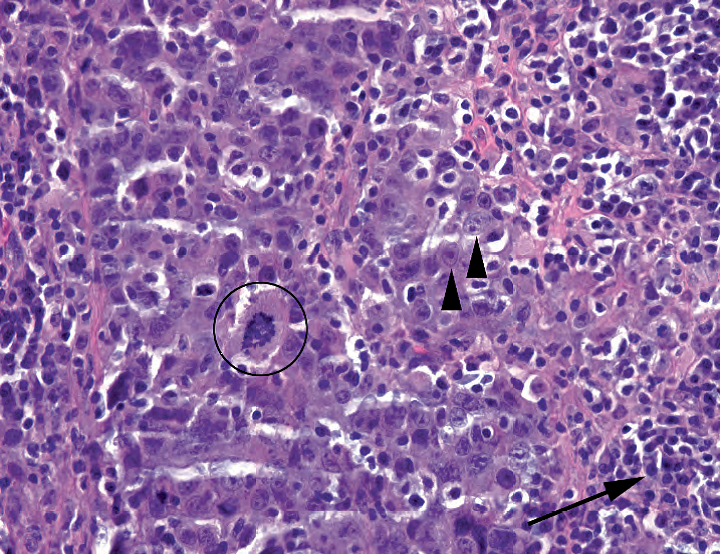
Figure 12.12. Lymphoepithelial-like carcinoma. The malignant cells (arrowheads) are almost obscured by the background of lymphocytes (arrow). Atypical mitoses are present (circle).
图12.12.淋巴上皮样癌。恶性细胞(箭头)几乎被淋巴细胞背景(箭)所掩盖。出现非典型核分裂(圆圈)。
来源:
The Practice of Surgical Pathology:A Beginner’s Guide to the Diagnostic Process
外科病理学实践:诊断过程的初学者指南
Diana Weedman Molavi, MD, PhD
Sinai Hospital, Baltimore, Maryland
ISBN: 978-0-387-74485-8 e-ISBN: 978-0-387-74486-5
Library of Congress Control Number: 2007932936
© 2008 Springer Science+Business Media, LLC
仅供学习交流,不得用于其他任何途径。如有侵权,请联系删除。
本站欢迎原创文章投稿,来稿一经采用稿酬从优,投稿邮箱tougao@ipathology.com.cn
相关阅读
 数据加载中
数据加载中
我要评论

热点导读
-

淋巴瘤诊断中CD30检测那些事(五)
强子 华夏病理2022-06-02 -

【以例学病】肺结节状淋巴组织增生
华夏病理 华夏病理2022-05-31 -

这不是演习-一例穿刺活检的艰难诊断路
强子 华夏病理2022-05-26 -

黏液性血性胸水一例技术处理及诊断经验分享
华夏病理 华夏病理2022-05-25 -

中老年女性,怎么突发喘气困难?低度恶性纤维/肌纤维母细胞性肉瘤一例
华夏病理 华夏病理2022-05-07







共0条评论